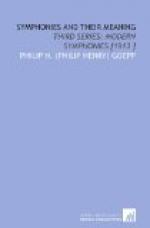[Music: Adagio (Muted strings) (Pizz. basses an 8ve. lower)]
There is an intimate charm, a true glamor of love-idyll about the Adagio. On more eager pulse rises a languorous strain of horn and cellos. The flow
[Music: (Horn and cellos with murmuring strings)]
of its passionate phrase reaches the climax of prologue where, the type and essence of the story, it plays about the lovers’ first meeting. As lower strings hum the burden of desire, higher wood add touches of ecstasy, the melting violins sing the wooing song, and all break into an overwhelming rapture, as though transfigured in the brightness of its own vehemence, in midst of a trembling mystery.
The restless spirit starts (allegro agitato) in fearsome agitation on quick nervous throb of melody; below, violas sing a soothing answer; there is a clear dialogue of wistful lovers.
Instead of the classic form of several verses led by one dominant melody to varied paths and views, here almost in reverse we seem to fall from a broader lyric mood to a single note of sad yearning that
[Music: (Fl. with Eng. horn an 8ve. below) (Muted violins with sustained lower strings)]
grows out of the several strains. Upon such a motive a new melody sings. The delicate bliss of early love is all about, and in the lingering close the timid ecstasies of wooing phrase. But this is a mere prelude to the more highly stressed, vehement song of love that follows on the same yearning motive. Here is the crowning, summing phase of the whole poem, without a return to earlier melody save that, by significant touch, it ends in the same expressive turn as the former languorous song.
The first melody does not reappear, is thus a kind of background of the scene. The whole is a dramatic lyric that moves from broader tune to a reiterated note of sad desire, driven to a splendid height of crowned bliss. The turbulence of early love is there; pure ardor in flaming tongues of ecstasy; the quick turn of mood and the note of omen of the original poem: the violence of early love and the fate that hangs over.
Berlioz has drawn the subject of his Scherzo from Mercutio’s speech in Scene 4 of the First Act of Shakespeare’s tragedy. He has entitled it “Queen Mab, or the Fairy of Dreams,” and clearly intends to portray the airy flight of Mab and her fairies. But we must doubt whether this, the musical gem of the symphony, has a plan that is purely graphic,—rather does it seem to soar beyond those concrete limits to an utterance of the sense of dreams themselves in the spirit of Mercutio’s conclusion:
“...
I talk of dreams
Which are the children of
an idle brain,
Begot of nothing but vain
fantasy;
Which is as thin of substance
as the air;”
And we may add, as elusive for the enchanted mind to hold are these pranks and brilliant parade of tonal sprites. It stands one of the masterpieces of program-music, in equal balance of pure beauty with the graphic plan.




